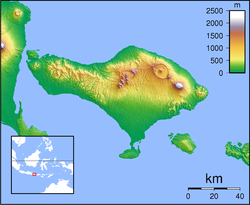Ubud
| Ubud | |
|---|---|
| Other transcription(s) | |
| • Balinese | ᬳᬸᬩᬸᬤ᭄ |

Monkey Forest Street in Ubud
|
|
| Location in Bali | |
| Coordinates: 8°30′24.75″S 115°15′44.49″E / 8.5068750°S 115.2623583°ECoordinates: 8°30′24.75″S 115°15′44.49″E / 8.5068750°S 115.2623583°E | |
| Country | Indonesia |
| Province | Bali |
| Regency | Gianyar |
| Time zone | UTC+08 |
Ubud is a town on the Indonesian island of Bali in Ubud District, located amongst rice paddies and steep ravines in the central foothills of the Gianyar regency. Promoted as an arts and culture centre, it has developed a large tourism industry.
Ubud has a population of about 30,000 people. It can be difficult for visitors to distinguish the town itself from the 13 villages that surround it. The area surrounding the town is made up of small farms, rice paddies, and dense forest.
Eighth-century legend tells of a Javanese priest, Rsi Markendya, who meditated at the confluence of two rivers (an auspicious site for Hindus) at the Ubud locality of Campuan. Here he founded the Gunung Lebah Temple on the valley floor, the site of which remains a pilgrim destination.
The town was originally important as a source of medicinal herbs and plants; Ubud gets its name from the Balinese word ubad (medicine).
In the late nineteenth century, Ubud became the seat of feudal lords who owed their allegiance to the king of Gianyar, at one time the most powerful of Bali's southern states. The lords were members of the Balinese Kshatriya caste of Sukawati, and were significant supporters of the village's increasingly renowned arts scene.
Tourism on the island developed after the arrival of Walter Spies, an ethnic German born in Russia who taught painting and music, and dabbled in dance. Spies and foreign painters Willem Hofker and Rudolf Bonnet entertained celebrities including Charlie Chaplin, Noël Coward, Barbara Hutton, H.G. Wells and Vicki Baum. They brought in some of the greatest artists from all over Bali to teach and train the Balinese in arts, helping Ubud become the cultural centre of Bali.
...
Wikipedia

